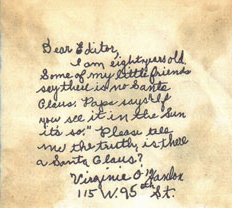Yes, Virginia, there is a Santa Claus
Yes, Virginia, there is a Santa Claus is one of the most famous editorials ever written and is a staple of Christmas literature. It was published in The New York Sun on September 21, 1897, and has since become part of American Christmas tradition. The editorial was written in response to a letter from 8-year-old Virginia O'Hanlon, who asked whether Santa Claus really existed.
Background[edit | edit source]
Virginia O'Hanlon, curious about the existence of Santa Claus after being teased by her peers, wrote a letter to The New York Sun, a prominent newspaper of the time. Her letter read: "Dear Editor, I am 8 years old. Some of my little friends say there is no Santa Claus. Papa says, 'If you see it in The Sun, it's so.' Please tell me the truth, is there a Santa Claus?"
The task of responding fell to Francis Pharcellus Church, a veteran editor at the newspaper. Church was known for his firm belief in the hopeful and the unseen, making him the perfect candidate to answer Virginia's query.
The Editorial[edit | edit source]
Church's response was a powerful and heartfelt editorial that did not simply answer the question but delved into the importance of faith, hope, and the beauty of maintaining a childlike wonder at the world. The most famous line from the editorial, "Yes, Virginia, there is a Santa Claus," has become an iconic affirmation of the Christmas spirit.
Church argued that Santa Claus exists as certainly as love and generosity do, and that he continues to make glad the heart of childhood. He emphasized that just because one cannot see things doesn't mean they are not real. The true essence of Santa Claus, he argued, is the love and joy he represents.
Legacy[edit | edit source]
The editorial has been reprinted countless times in various languages and media. It is a reminder of the power of belief and the importance of nurturing the imagination and goodwill in the world. The phrase "Yes, Virginia, there is a Santa Claus" has entered the lexicon as a general affirmation of belief in the intangible.
The story of Virginia O'Hanlon and the editorial has inspired books, animated television specials, and movies, further cementing its place in Christmas lore. Virginia herself went on to lead a fulfilling life, always cherishing the response she received and the impact it had on the world.
Cultural Impact[edit | edit source]
The editorial's message transcends the question of Santa Claus's existence, touching on deeper themes of faith in the unseen and the importance of maintaining a sense of wonder. It serves as a reminder of the joy and magic that can be found in life, encouraging readers of all ages to believe in the goodness and beauty that may not always be visible.
See Also[edit | edit source]
This cultural related article is a stub. You can help WikiMD by expanding it.
Search WikiMD
Ad.Tired of being Overweight? Try W8MD's physician weight loss program.
Semaglutide (Ozempic / Wegovy and Tirzepatide (Mounjaro / Zepbound) available.
Advertise on WikiMD
|
WikiMD's Wellness Encyclopedia |
| Let Food Be Thy Medicine Medicine Thy Food - Hippocrates |
Translate this page: - East Asian
中文,
日本,
한국어,
South Asian
हिन्दी,
தமிழ்,
తెలుగు,
Urdu,
ಕನ್ನಡ,
Southeast Asian
Indonesian,
Vietnamese,
Thai,
မြန်မာဘာသာ,
বাংলা
European
español,
Deutsch,
français,
Greek,
português do Brasil,
polski,
română,
русский,
Nederlands,
norsk,
svenska,
suomi,
Italian
Middle Eastern & African
عربى,
Turkish,
Persian,
Hebrew,
Afrikaans,
isiZulu,
Kiswahili,
Other
Bulgarian,
Hungarian,
Czech,
Swedish,
മലയാളം,
मराठी,
ਪੰਜਾਬੀ,
ગુજરાતી,
Portuguese,
Ukrainian
Medical Disclaimer: WikiMD is not a substitute for professional medical advice. The information on WikiMD is provided as an information resource only, may be incorrect, outdated or misleading, and is not to be used or relied on for any diagnostic or treatment purposes. Please consult your health care provider before making any healthcare decisions or for guidance about a specific medical condition. WikiMD expressly disclaims responsibility, and shall have no liability, for any damages, loss, injury, or liability whatsoever suffered as a result of your reliance on the information contained in this site. By visiting this site you agree to the foregoing terms and conditions, which may from time to time be changed or supplemented by WikiMD. If you do not agree to the foregoing terms and conditions, you should not enter or use this site. See full disclaimer.
Credits:Most images are courtesy of Wikimedia commons, and templates, categories Wikipedia, licensed under CC BY SA or similar.
Contributors: Prab R. Tumpati, MD


